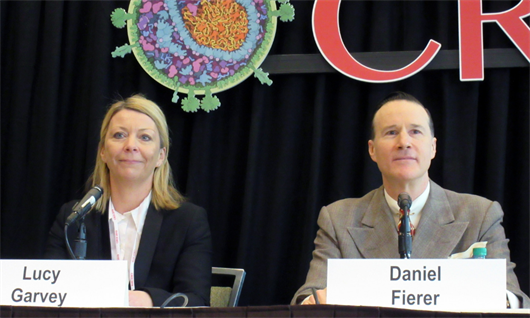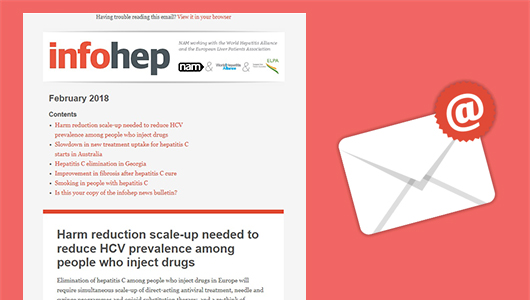Hepatitis C drops among HIV-positive London gay men after direct-acting antiviral scale-up 
Lucy Garvey and Daniel Fierer at CROI 2019. Photo by Liz Highleyman. New cases of hepatitis C virus (HCV)
infection among HIV-positive gay and bisexual men receiving HIV care at three
clinics in London have declined by nearly 70% since 2015, according to a
presentation at the Conference on Retroviruses and
Opportunistic Infections (CROI 2019) in Seattle.
The drop is largely attributable to
regular HCV screening and a treatment-as-prevention effect resulting from wider
use of direct-acting antiviral (DAA) therapy, especially during acute
infection.
The British HIV Association aims to
cure HCV in everyone with HIV and HCV co-infection by 2021. However, current
NHS guidance does not permit DAA treatment for people with acute HCV infection.
Three London clinics were able to offer DAA treatment to people with acute HCV
infection through clinical trials. They observed a sharp decline in new
infections after 2015. The proportion of reinfections relative to all acute
infections rose over time, from less than a tenth (9%) in 2013 to nearly half
(47%) in 2018.
A study in New York, looking at men
who have sex with men who were diagnosed with acute HCV infection and
subsequently cured, also found a very high rate of reinfection – 4.4 per 100
person-years of follow-up.
Researchers
discussing these studies at the conference said that preventing sexual
transmission of HCV among men who have sex with men is proving to be
challenging. The high incidence of HCV among men who have sex with men with HIV is
partly a consequence of the high prevalence of HCV in this group and the
preference for other partners with HIV. A decline in condom use due to greater
use of pre-exposure prophylaxis (PrEP) to prevent HIV may be contributing to a
higher incidence of hepatitis C among men who have sex with men, but it is not
clear whether promotion of condom use would be enough to reduce HCV incidence.
Although HCV can be found in semen and rectal fluid, it is not clear to what
extent blood exposure during practices such as fisting or sharing of injecting
equipment may be contributing to HCV transmission between men who have sex with
men. Greater access to DAAs during acute infection is needed to reduce
incidence, as well as harm reduction.
HCV reinfection in people who inject drugs a sign of a successful treatment programme, say researchers High
rates of reinfection in people who inject drugs are a sign that access to
treatment is improving, not a sign of failure, and should prompt retreatment,
not stigmatisation, Australian hepatitis researcher Greg Dore says in the Journal
of Viral Hepatitis this month.
He
was commenting on a recently published study of hepatitis C treatment and
hepatitis C virus (HCV) reinfection among high-frequency injectors in Dundee,
Scotland.
Only
someone who is cured can get reinfected, so a higher frequency of reinfection
in people who inject drugs means that treatment programmes are reaching people
who inject drugs and curing them. The high rate of reinfection is a sign that
harm reduction interventions such as needle and syringe programmes and opioid
substitution therapy are not being offered at sufficient scale or are not
engaging people at highest risk of reinfection.
The
Eradicate study was designed to evaluate engagement in treatment, cure rates
and reinfection rates among active injectors attending needle and syringe
programmes in the city.
The
study was carried out between 2012 and 2016 when the standard of care was
pegylated interferon plus a protease inhibitor for genotype 1 and pegylated
interferon and ribavirin for genotypes 2 and 3. The study achieved a high cure
rate (82%). There was a high reinfection rate: after 18 months the rate was
21.49 per 100 person-years. The HCV reinfection rate in this study is similar
to the community incidence of HCV in Scotland. The investigators say that the
high rate of reinfection shows that they are engaging people with a very high
risk of HCV infection in care and successfully curing them of hepatitis C.
In an accompanying Comment article, Professor Greg Dore of the
Kirby Institute, University of New South Wales, Sydney, said that modelling of
treatment uptake in Australia suggests that reinfection rates among people who
inject drugs can be expected to rise until 2023 if Australia continues to
achieve high rates of treatment among drug users, before beginning to decline
as the number of people who inject drugs with chronic HCV infection begins to
decline substantially.
“Intensive injecting network exploration and screening could be
utilised for those who develop HCV reinfection,” he says, noting that sexual
partners are often injecting partners too. Ongoing monitoring of reinfection,
point-of-care technologies that can detect HCV RNA – such as fingerprick
sampling – and rapid initiation of treatment will all contribute to efforts to
reduce reinfection in people who use drugs.
US Department of Veterans Affairs on track to cure 100,000 of hepatitis C The US Department of Veterans Affairs (VA), which
provides medical care for US military veterans, has cured almost 100,000
veterans of hepatitis C using direct-acting antivirals (DAAs). Hepatitis C is
approaching elimination among US military veterans, the Department said in a
press release last week.
Prior to the introduction of DAAs,
approximately 180,000 veterans were living with hepatitis C. Since 2014,
116,000 have started a course of DAAs and so far, 96,654 have completed
treatment and been cured.
Aggressive case-finding allowed nearly 2000
people to start treatment every week and the VA expects to have treated 125,000
veterans by October 2019.
The high treatment rate has also been made
possible by negotiating low prices for DAAs. The
VA estimates that the cost of curing each veteran is approximately $25,000 in
2018 as a result of being able to bring down drug costs.
Hepatitis C treatment reduces risk of diabetes Treatment of hepatitis C virus (HCV)
infection is associated with better glucose control and a lower likelihood of
developing diabetes, according to a report at CROI 2019. People with hepatitis C are at higher
risk of developing type 2 diabetes but it has been unclear if curing hepatitis
C reduces the risk of developing diabetes. A recently published
US study with 384 participants showed
that although direct-acting antiviral (DAA) treatment resulted in a short-term improvement in glucose
control in people who already had type 2 diabetes, improvement was not
sustained.
This month, US researchers reported on
the incidence of type 2 diabetes in 52,000 US military veterans with hepatitis
C, including 21,279 who had been treated with DAAs.
The study found that DAA treatment was
associated with a 52% reduction in the risk of developing diabetes. Further
prospective cohort research which includes a larger population of women is
needed to validate this finding.
Hepatitis C treatment safe and effective in pregnant women, pilot study shows 
Catherine Chappell speaking at CROI 2019. Photo by Liz Highleyman. Treatment with sofosbuvir/ledipasvir (Harvoni) was well tolerated and likely cured nine out of nine pregnant women with
hepatitis C virus (HCV), according to a small study presented at CROI 2019. While 'baby boomers' have traditionally
had the highest rate of hepatitis C in the United States, HCV incidence is
rising among younger people, tracking
the ongoing opioid epidemic. This means more women of childbearing
age are infected with HCV and at risk of transmitting the virus to their
babies, but there has been little research on the use of direct-acting
antivirals (DAAs) as treatment for this group.
DAAs remain understudied
in pregnant women. For example, it is not known how DAAs affect birth outcomes
such as the risk of stillbirth, premature delivery or birth weight. As women
have rarely been exposed to DAAs at the time of conception or during early
pregnancy, there is also a lack of real-world information about how DAAs affect
foetal development during the first three months of development, which is the
period of greatest risk for birth defects caused by exposure to a drug.
The small phase 1 study tested was
designed to test the safety of sofosbuvir/ledipasvir in pregnant women. Nine
women were recruited to the study. Eight women were cured and one is still completing SVR follow-up. All nine carried
their pregnancies to term and all had undetectable HCV at the time of delivery.
All but one of the infants were delivered at term and were of normal weight.
None of the infants show evidence of HCV infection, including five who have
been followed for a year. No safety concerns were reported in this study
population, but larger studies are needed to confirm the safety of DAAs in
pregnancy and to test other drugs, especially pangenotypic regimens.
Hepatitis B virus raises the risk of age-related macular degeneration Macular degeneration is a condition in
which the centre of the field of vision becomes blurred or invisible. It is an
age-related condition, but its causes are not well understood. Smokers have a
higher risk of macular degeneration.
A study in Taiwan has found a strong
association between hepatitis B infection and macular degeneration. The
researchers looked at the incidence of macular degeneration between 2000 and
2012 in Taiwan and found that people with hepatitis B had a 41% increase in the
risk of macular degeneration.
The researchers say that hepatitis B
has been associated with eye conditions in studies in other Asian countries and
that physicians should be alert for eye problems in people with hepatitis B,
especially loss of vision.
EndHep2030 call for proposals The Fund for Elimination of Viral
Hepatitis – EndHep2030 – will launch in April.
The fund will provide grants to speed
the elimination of viral hepatitis by supporting the development of sustainable
strategic plans at the national and sub-national level to guide effective
programme implementation; by showing how countries can optimise their human and
financial resources within health budgets; by increasing the availability of
country-specific data that inform where and how to intervene most efficiently
and effectively; and, by building health system capacity to deliver quality
hepatitis prevention and treatment services.
The fund is supported by the Robert
Wood Johnson Foundation, the Zeshan Foundation, the CDC Foundation and the John C. Martin
Foundation, and also intends to catalyse donor support for viral hepatitis
elimination efforts.
The fund is seeking proposals for a
first round of funding in 2019. View the call for proposals at: endhep2030.org/grants
World Hepatitis Alliance appoints new CEO and President The World Hepatitis Alliance (WHA) has announced that, following a
comprehensive interview process, Cary James has been selected as CEO and will
begin on 8 April. Cary brings decades of experience in public health programmes
and health policy at the national and international levels. He is a recognised
leader in putting patients and communities at the centre of policy and
programmes.
“I am excited for this opportunity to use my skills
and experience to champion our members and people affected by viral hepatitis
to make viral hepatitis elimination a reality,” Cary said.
Cary has worked extensively in hepatitis and HIV response, having
developed innovative and successful campaigns and collaborated with numerous
civil society organisations during his time as a member of the leadership team
at the UK’s Terrence Higgins Trust. He has been a member of international advisory
panels and expert groups on diagnostics, digital communications, health
equality, HIV, hepatitis, tuberculosis and sexual health.
“Cary has a proven record of working closely with
governmental and non-governmental organizations to tailor programmes to unique
populations as well as high-level engagement with the WHO and UN, which are
important skills in the work of the Alliance,” says Michael
Ninburg, president of WHA.
“I am delighted to be passing on the torch to Cary
who will be a great fit to the organization and an exciting appointment to
drive the Alliance forward,” added Raquel Peck,
senior advisor and former CEO of WHA.
Dr Su Wang has been appointed WHA President-Elect, having served on the
executive board of the WHA since 2014 as a regional representative for the PAHO
region. Su is an internal medicine physician who discovered she had hepatitis B
after donating blood in college and has used her own personal experience to
advocate for the elimination of hepatitis. She worked for many years in New
York City leading outreach and care programmes for hepatitis B patients and now
directs a number of hepatitis B and C programmes in her current role as Medical
Director for the Center for Asian Health at Saint Barnabas Medical Center in New
Jersey.
Next month: News from The International Liver Congress Next month, infohep will be providing news coverage from The International Liver Congress 2019, organised by the European Association for the Study of the Liver (EASL). The conference is taking place in Vienna, Austria from 10-14 April. We will be publishing news online and the April infohep bulletin will be dedicated to news from the conference.
Is this your copy of the infohep news bulletin? 
Is this your copy of the infohep news bulletin, or did you receive it from a friend or colleague, or find it online? You can sign up to receive this monthly email bulletin, free of charge, on our website, where you can also find an archive of all the infohep news bulletins.
|





Connect with infohep on Facebook: Keep up to date with all the latest news and developments.
Follow infohep on Twitter for links to news stories and updates from infohep.org. Follow us at www.twitter.com/infohep.
Follow all the infohep news by subscribing to our RSS feeds.